| |
Tactical Awareness Consulting created by Katz Noguchi 18/11/2006
|
|
| |
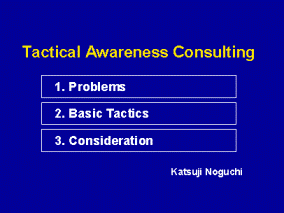 |
My name is Katsuji Noguchi form Tokyo, Japan. I have been playing squash for 17 years.
I was working for a company as a professional of Value Engineering, when I was playing squash in tournaments 10 years ago. Value Engineering is one part of industrial engineering, which aims partly at making the connection between the purpose of the task and the measure of the task. I applied it to squash tactics. I would like to talk about it in my presentation. It takes only 30 minutes.I hope you wouldn’t get too bored.
1.Problems
Sometimes, it seems a little strange to me that there are some players whose shots when not under the pressure can be clearly predictable by the opponent especially by top level players. |
| |
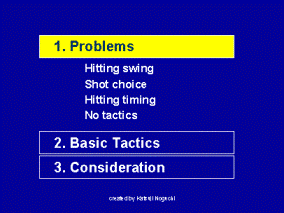 |
| |
There are some more strange things. Some players always hit a crosscourt after a couple of straight drives from back corners. Some players choose a boast only because the ball comes to a place where it is easy to hit a boast.
Some players do not play a drop shot till the opponent comes back to the“T,” though the opponent was pushed to the back wall by the previous shot.
I think many players are playing without tactical thinking.
They may not be so big problems for top level players who have good physical abilities. But, for players who are not on the top level, they are not only a serious problem to win the game, but also a big problem to enjoy playing squash.
In general, squash players start training with shot training when they are beginners. They repeat and repeat such practices for all kinds of shots. Their shots are getting better and more accurate. The next training is pattern training. Players practice various kinds of patterns repeatedly. And, they are getting better at pattern training. But, the purpose of the training is not always explained to players. So, it often happens that shots and shot choices in the pattern training are very good, but they do not work in the actual games.
|
|
| |
Players are likely to choose a shot that is not considered to be the best to win, but a shot that they want to hit or a shot that is easy to hit for them in the games. Even if they scored a point by that shot, they may not be able to again after that, because they didn’t intend to do it in the first place.
Their games are often only to run and hit the ball, to hope it scores a point, and to run to the ball again if the opponent gets to it.
It may be good for physical exercise, but the probability to win the game is going down.
I think these problems are due to a lack of basic principles in playing squash. They are not so difficult to understand. They just define how to choose shots, how to score points and not to lose points, and how to win the game.
I call these principles “Basic Tactics.”
I
will talk about what is “Basic Tactics” and how to teach “Basic Tactics” to players in the next chapter
.
|
 |
|
| |
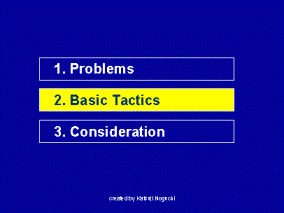 |
|
| |
|
| |
2.Basic Tactics
What we have to teach players in the first place is that there are three kinds of squash shots. They are not the kinds of actual shots like straight drive, boast, or drop shot.They are categorized by the purpose of shots.That is because, in the game, I think it is more effective to think of the purpose of the shot first than to choose the actual shot.
|
|
| |
|
They are
1. Pressure Shot
2. Winning Shot
3. Safety Shot
The purpose of the shots are as follows.
1.Pressure Shot --- To make the opponent move away from the “T”.
2.Winning Shot --- To score an actual point.
3.Safety Shot --- Not to lose a point.
|
|
| |
What we have to teach them next is that it is difficult to score a point if the opponent is at the“T”.Also, teach them that that is the way of how to play the game of Squash.
Then, they can easily understand they have to make the opponent move away from the “T” and make him run to one of the corners with their first shot. And then, they have to hit the second shot to the other corner before the opponent comes back to the “T” in order to score a point.
|
|
| |
It is very important for them to understand that it is not a good choice only to hit good shots continuously to try to score points, even if they were praised, “Good shot” by the coach in their shot training.
Also, it would be very easy for them to understand that they do not lose the next point easily if they can keep the “T” when the opponent hits the ball.
Every player knows it is necessary to score points, and to lose points as least as possible in order to win the game. So, they know how to win the game basically.
|
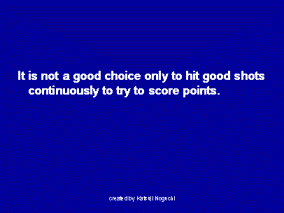 |
|
| |
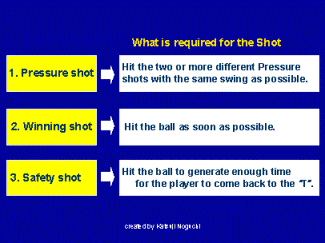 |
What we have to teach players next is what is required for each shot, that is, Pressure Shot, Winning Shot, and Safety Shot.
For Pressure shot, its purpose is to make the opponent move away from the “T”and not to give him enough time to come back to the “T”. Good control, good speed? Not necessarily, because every one can expect them.
It is to make the opponent’s start toward the ball delayed. It has the same effect as good control or good speed. To do this, the following is needed.
|
|
| |
1.Pressure Shot --- Hit the two or more different Pressure Shots with the same swing as possible.
The opponent cannot quickly identify which shot is coming and that delays his start toward the ball.
The Winning Shot is mainly used after Pressure Shot. It means that the opponent is not at the “T”. So, the following action is needed.
2.Winning Shot --- Hit the ball as soon as possible.
It does not matter if the shot is expected.
For the Safety Shot, the purpose is not to lose a point. It means to stand at the “T” when the opponent hits the ball. So, the following is needed.
3.Safety Shot --- Hit the ball to generate enough time for the player to come back to the “T”.
For example, as for a drop shot, it is important to tell them that the drop shot as a Pressure Shot and as a Winning Shot are entirely different. Hitting swings and impact timing are also different.
|
|
| |
Finally, we have to teach players how to choose shots in the actual games. When they choose a shot during the rally, the first thing they have to recognize is whether that situation is the right time for attack or for defense. If they attack, they should choose a Pressure Shot such as a drop shot, boast, or straight drive to make the opponent run to the front or the back corner. And, then hit the Winning Shot to the other corners. If they defend, hit the Safety Shot such as a lob or straight drive down the side wall.
It is easy to teach with my Tactical Chart.
|
|
 |
| |
My Tactical Chart shows the flows of how to choose a shot by the situation. The relationship between items adjacent to each other is the “Purpose” and the “Measure”. The “Purpose” is on the left side and the “Measure” on the right side. In order to accomplish the Purpose of "To win the game", there are Measure "To score a point" and Measure "Not to lose a point", and if "To score a point" turns into the Purpose, the right side items are Measures for that Purpose. Each shot in the far right column of this chart is the shot that players choose as the final Measure.
We have to teach players that they should do these things immediately the opponent hits the ball.
When I am coaching their game training, I pay not much attention to the results such as whether they score or not, but more to the process or their mind-set.I sometimes stop their rally and ask them the purpose of the previous shot if they seem to play without thinking.
Sometimes it takes a long time to teach them “Basic Tactics”. But I think it necessary.
|
|
| |
3.Consideration
I have been teaching my “Basic Tactics” to squash players for 5 years. And there are several things I have found from that.
First,it is very important to teach it to players at the right time for them. It is too advanced to teach “Basic Tactics” to beginners. It has to be taught after they finish learning all kinds of shots.
When they are advanced or intermediate players, it is not a problem for most of them whoseswings are plain. But, some of them have their own unique hitting swings. And, sometimes they are harmful for “Basic Tactics”. |
|
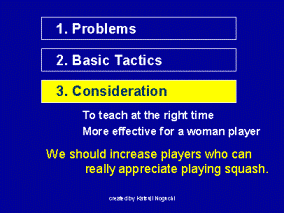 |
For example, one player’s straight drive is fast and has a good control, but he can never change his shot after starting swing because of his own unique hitting style. It means that he can hit a good shot, but not a shot “Basic Tactics” requires.It is not so easy to correct a unique hitting style which has been used for a long time.
So, I think the best time to teach “Basic Tactics” is when they have just finished beginners or are in the first stage of intermediate. |
| And the next,my “Basic Tactics” was more effective for a woman player than for a male. I think it is maybe because men’s footwork is faster than women’s, but men’s ball speed is not so much faster than women’s. It means that it is easier for a woman player than for a male to make a Winning Shot by using a Pressure Shot. |
And the next, it sometimes embarrassed me that there were some top players appeared on DVD whose play had nothing to do with my “Basic Tactics.”They won many tournaments because of their good footwork and technique. But, I think they might have played better with good tactics.
One player asked me,
“Can I believe you? Jonathan Power is not playing as you tell me.”
It is very easy to answer this question logically, but actually it is not so easy to explain.
|
 |
Ultimately, I believe there are two kinds of players, some are interested in my coaching, others not at all. It could mean that some like to play squash with thinking, others not. Or, some think squash is like a chess game on the court, others only a sport which is similar to tennis.
Having played squash in some European countries and Japan for the last three years, I have noticed that the number of squash courts is decreasing in these countries. Squash seems to be getting less popular.
Many sports could replace squash if it were only for physical exercise.
I think we should try to increase players who can really appreciate playing squash.
Thank you very much for your listening to my presentation. In Japanese, “DOMO ARIGATO ” |
|